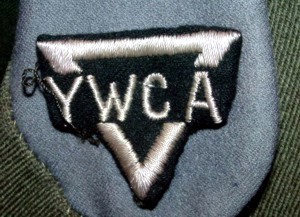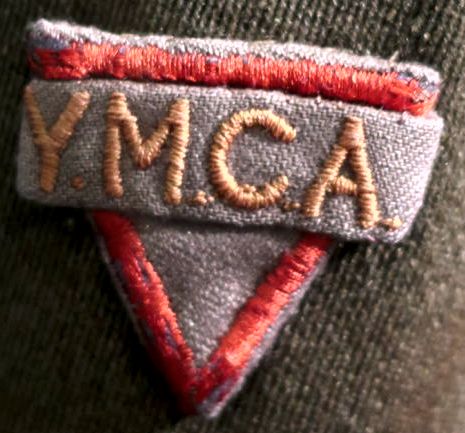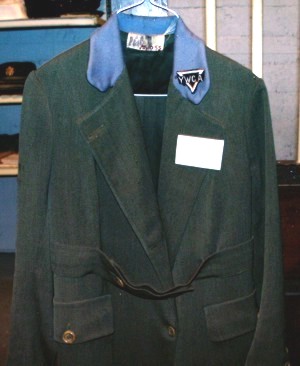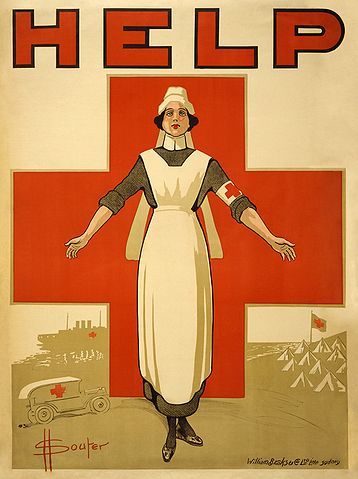WW1 support networks
YMCA, Salvation Army and Red Cross
World War 1:
35,000 unpaid volunteers and 26,000 paid staff served in the YMCA during the First World War assisting the needs of the 4.8 million troops.
All photos on this page from "That Damn Y", by Katherine Mayo, 1920, unless otherwise specified.
They suffered 286 casualties and were awarded 319 citations and decorations including the French Legion d’Honneur, Order of the British Empire, and the Distinguished Service Cross and Distinguished Service medal. Women served throughout the front lines but did not serve in top administrative roles.
- They operated 26 R&R leave centers, 1,500 canteens, and 4,000 “huts” serving 2 million American servicemen.
- The YMCA awarded 80,000 educational scholarships to veterans after the Great War, a forerunner of the GI Bill.
- They also provided humanitarian services to more than 5 million prisoners of war on both sides, keeping records and facilitating correspondence and information to families.
- They served on troop trains, canteens, post offices distributed cookies and candy, and organized 1,470 entertainers to tour overseas.
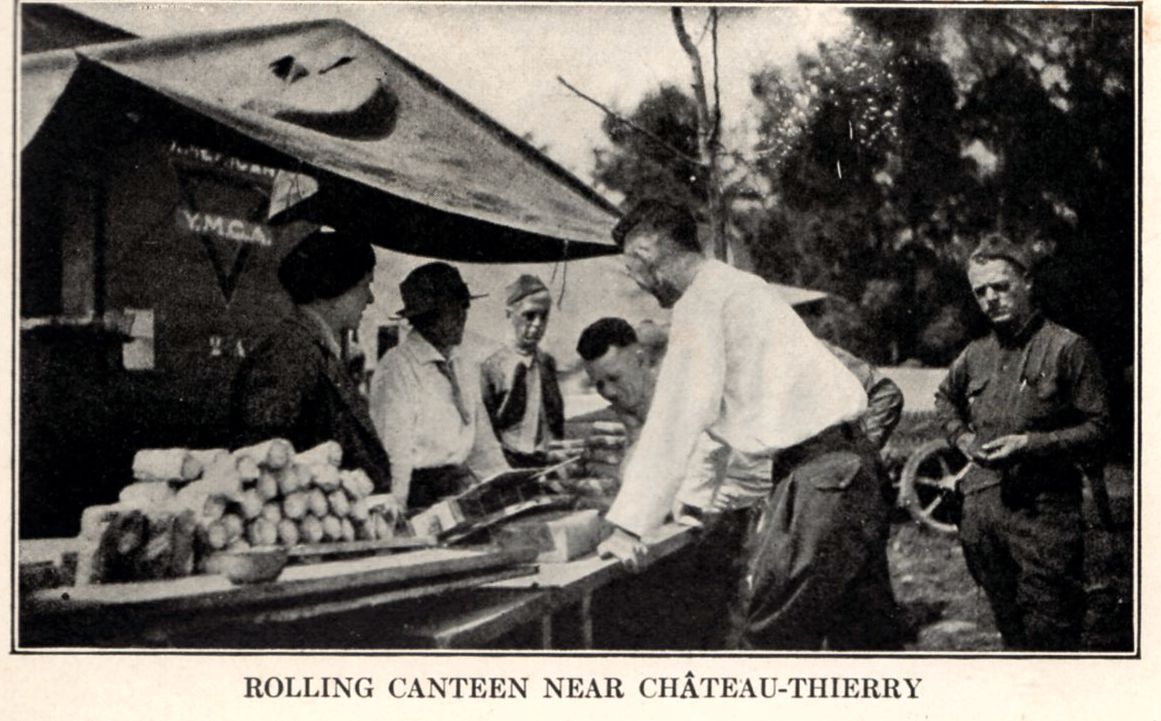
They served on the battlefields with horse-drawn canteens, built huts, prefabricated chapels, and utilized tents near the front lines. They had 4,000 huts, served food aboard the 8,000 troop trains, and maintained a Hotel for R&R in England for soldiers' furloughs.
WW1 YMCA recruiting poster
US Army Signal Corps
The YMCA served over 90% of AEF overseas troops.
They were the first private social organization to offer their service in the time of war. They were joined by the Red Cross which was organized in 1900.
Never in the United States history had an organization aided so many troops over such a wide geographic area and under wartime conditions. They organized areas of respite from the war providing writing materials, free meals, recreation, entertainment, taught classes to learn to read and write and others such as drawing and architecture, offered religious guidance, reading material, and clothing.
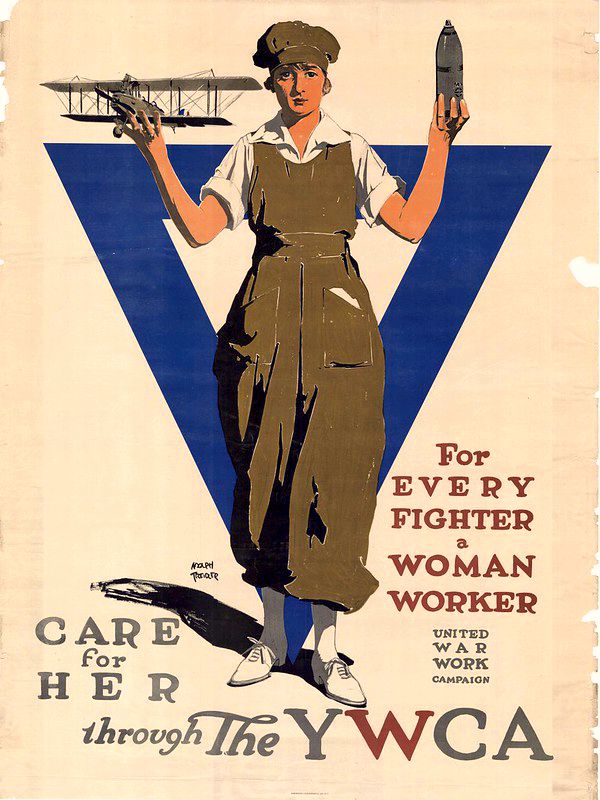
The YMCA on the front lines
Twenty-six thousand paid staff of men and women served during the war. More than half served behind the front lines in huts in training camps, mobile canteens, and "leave areas" aiding in welfare and recreation but 57 lives were lost in the Great War by Y workers. Two were killed by shell fire while operating under a YMCA banner. Thirty-nine died of disease and eighteen died from shell-fire, gas poisoning, drowning or wounds received while aiding the troops. Thirteen of the WMCA workers lost were women. One lost her life in a German raid and one was killed by shell fire. Most light casualties were not reported as the Y attended aiding the troops but there were 55 non-fatal casualties that were reported. Casualties were from machine-gun fire, shell fire, gas, and transport accidents.
Three hundred and nineteen Y workers were cited for meritorious service which included:
- 1 French Legion of honor
- 13 Croix de Guerre (awarded by the French for bravery)
- 3 Distinguished Service Cross
- 3 The Order of St. Stanislaus
- 5 Italian Cavalier del Corona
- 38 Italian War Cross
- 1 French Corps d'Atmee
- Order of the British Cross
- US Distinguished Cross
- US Distinguished Service medal
14 Other medals of distinction were awarded, 6 Meritiourius conduct recommendation, and 29 Y workers were cited for honorable mention. Unit citations were granted for units that worked with the 3rd Division.
The all of men that volunteered had been turned down for military duty but wished to serve in a time of war. They were exposed to shell fire, machine-gun fire, and toxic gas but continued working as stretcher-bearers and ambulance drivers to aid and comfort the wounded.
They accommodated almost two million American officers and enlisted men in twenty-six R&R centers throughout France.
YMCA workers carrying supplies to the troops.
YWCA Sleeve Patch
IWM Museum Collection
WW1 WMCA Shoulder patch
WW1 Salvation Army Home Service Pin
YMCA WW1 Uniform
Indiana War Memorial Museum Collection
Red Cross Nurses
Recruiting Poster
WW1
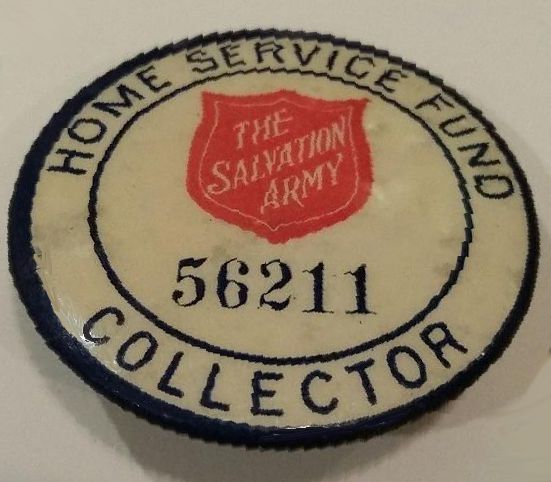
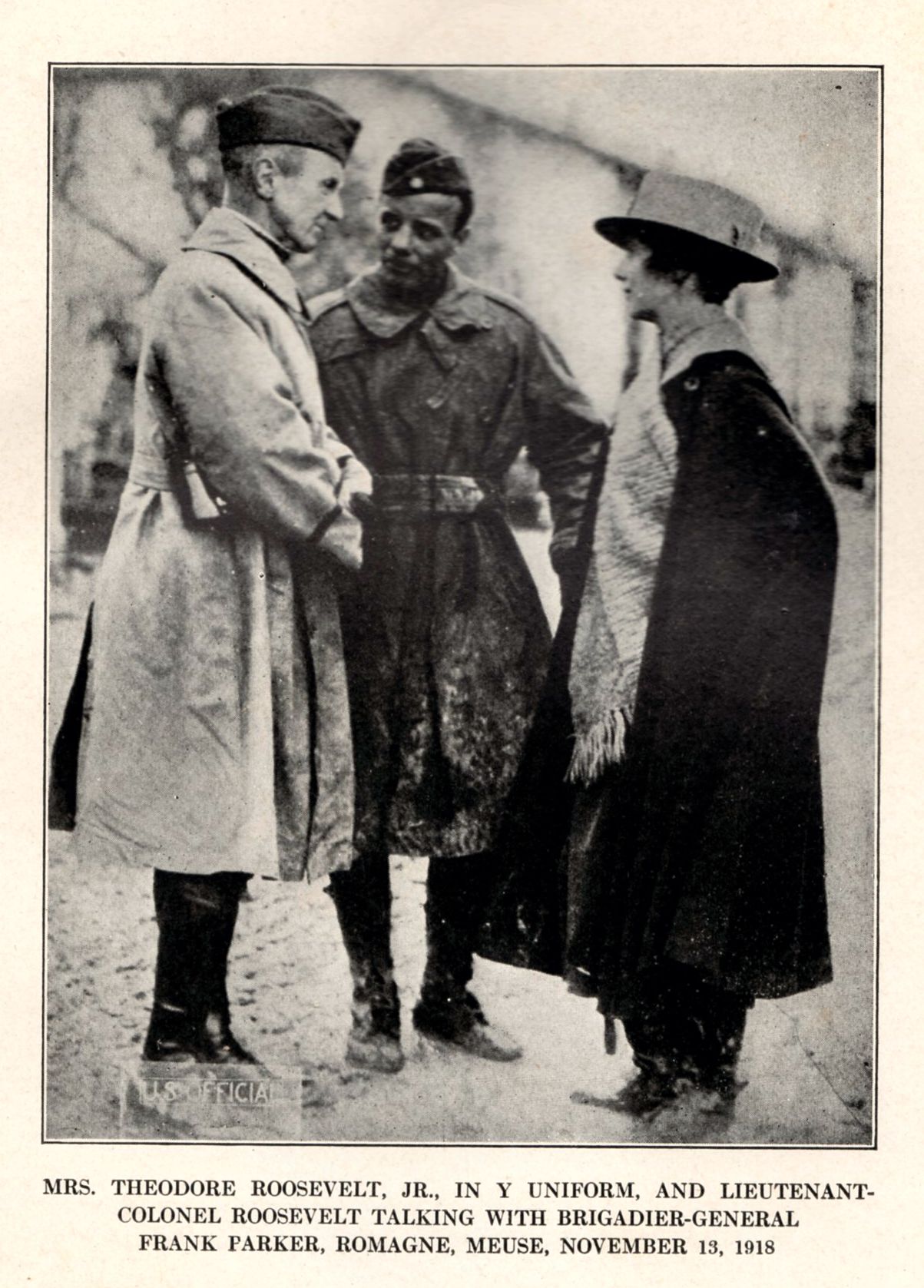
Mrs. Theodore Roosevelt, Jr. in Y Uniform with Lt. Col. Roosevelt talking with Brigadier-General Frank Parker, Romagne, Meuse, November 13, 1918
Red Cross Nurses in a postwar parade in Indianapolis
Photo courtesy of Stan & Sarah Seivers
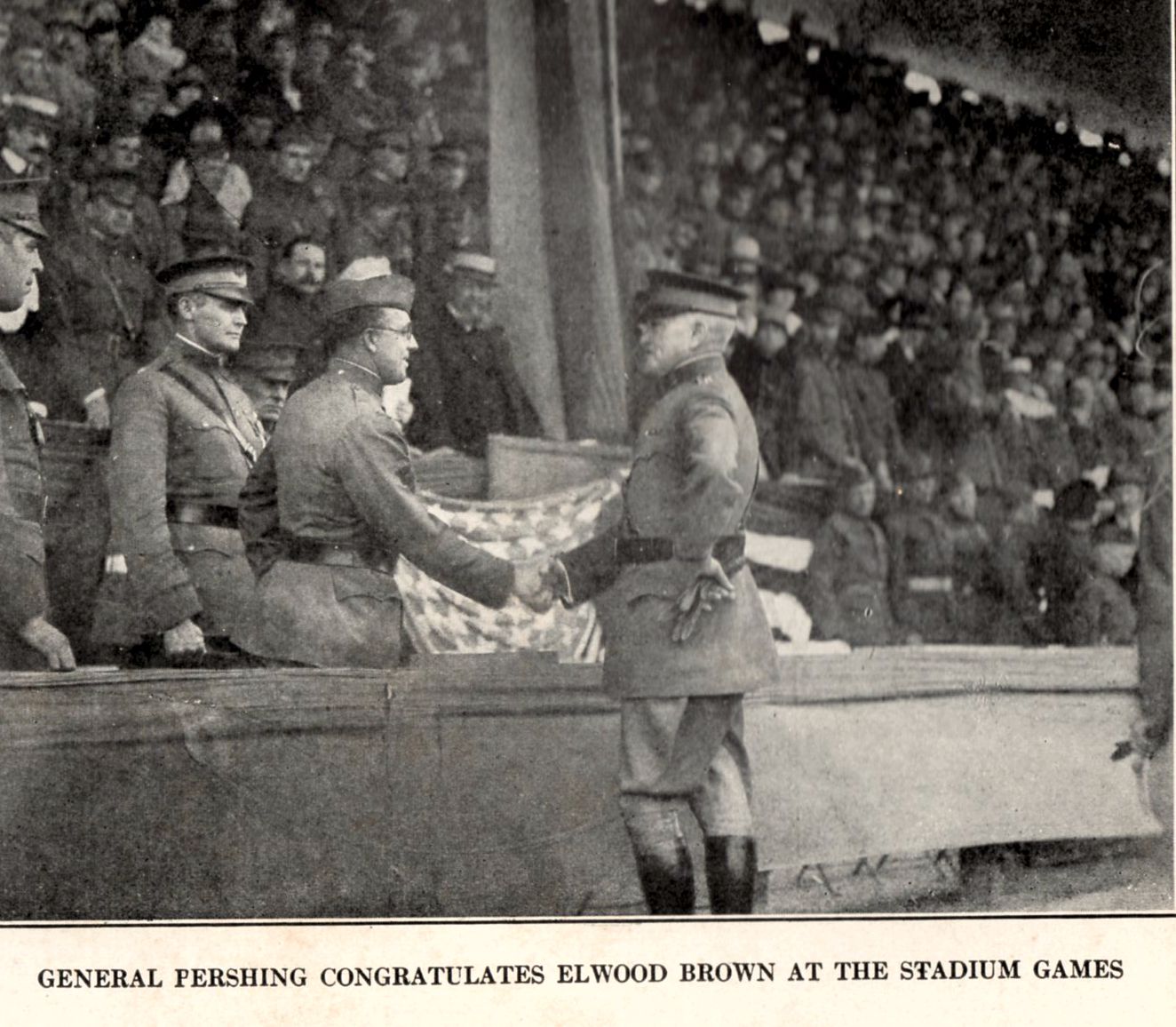
General Pershing congratulates Elwood Brown at the Stadium Games. Mr. Brown organized the AEF championship and Inter-Allied games modeled after the Olympic Games in cooperation with the YMCA. They were held in June and July 1919
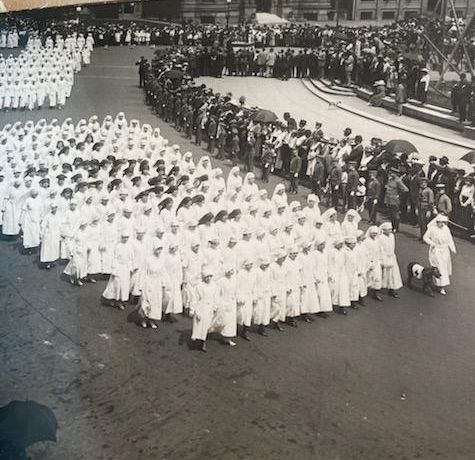
The Salvation Army in the Great War
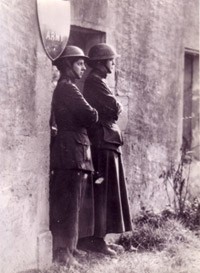
Ensigns Purviance and Sheldon made seven doughnuts in their first batch. They were received with such enthusiasm by the troops they made 150 Doughnuts that day. The word went out of the delicious treats and they made 300 the next day.
Eventually, Ensign Purviance was making 8,000 doughnuts a day.
There were only 250 volunteers on the front lines in Europe but they had a huge impact on troop morale.
“Before the war I felt that the Salvation Army was composed of a well-meaning lot of cranks. Now what help I can give them is theirs,” wrote Theodore Roosevelt, Jr., son of the former president, after serving in France.
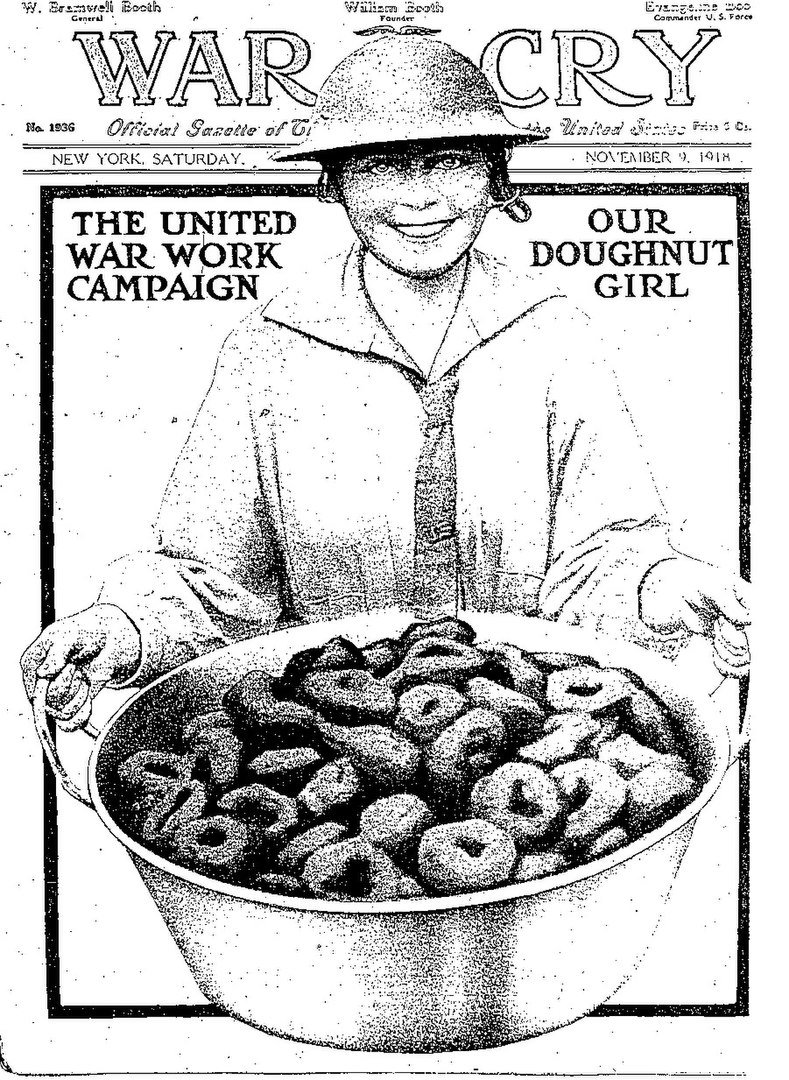
By Salvation Army "War Cry" magazine, November 9, 1918 - http://www.stonefortconsulting.com/wp-content/uploads/2011/10/donuts.gif, Public Domain, https://commons.wikimedia.org/w/index.php?curid=26516479
Salvation Army workers in France
Photo courtesy of Indiana War Memorial Archives
Anna Barnes Moore
Salvation Army,
Miami County, Indiana
"My work, for a time, was to visit the soldiers in hospitals, delivering supplies such as toilet articles, oranges, lemons, candy, dates etc. and fixing such things as they could eat or call for. I also worked in the huts. Our regular work was making donuts and pies and having religious meetings when convenient. Oranges and lemons were brought from Italy; nuts, dates, figs from Belgium; other supplies from America. All we could do seemed little among so many."
Women who volunteered for the front line service in the Salvation Army were issued gas masks, helmets, and .45 caliber revolvers.
Donut Day History
from the Salvation Army website: https://centralusa.salvationarmy.org/metro/donut-day-history/
"In 1917, The Salvation Army began a mission to provide spiritual and emotional support for U.S. soldiers fighting in France during WWI. About 250 volunteers traveled overseas and set up small huts located near the front lines where they could give soldiers clothes, supplies, and, of course, baked goods. After discovering that serving baked goods would be difficult considering the conditions of the huts and the limited rations, two volunteers – Ensign Margaret Sheldon and Adjutant Helen Purviance – began frying donuts in soldiers’ helmets. These tasty treats boosted morale and won the hearts of many soldiers. Nicknamed “Donut Lassies,” the women who served donuts to troops are often credited with popularizing the donut in the United States when the troops (nicknamed “doughboys”) returned home from war.
During WWI, Donut Lassies served coffee and donuts to soldiers in the trenches. Donuts were not the reason The Salvation Army workers were in the fighting zones; they were there primarily to give spiritual aid and comfort to the American soldier and his allies. They were there to be a link with home and family. The Salvation Army continued to provide comfort, care, and donuts to American soldiers during World War II, and is honored to continue to serve the men and women who have served our nation."
In 1937 The Salvation Army started National Doughnut Day, the first Friday of June each year, as a fundraiser in Chicago. It was to raise funds for the needy during the Great Depression and honor the Salvation Army "Lassies of World War 1" who served doughnuts to soldiers,
The term "Doughboy" is often attributed to the Salvation Army "Doughnut Dollies" and their welcome doughnuts but it was used as early as the Mexican-American War of 1846-47 to refer to the American Troops. The infantrymen made long hikes over dusty terrain and the dust made them appear as if they were covered with flour.
Another theory of the term cites the use of clay applied to the piping of the Continental Army soldiers to keep the piping white. They became "doughy" in the rain.
These are stories from post-war interviews conducted by the Indiana Historic Commission:
Grace Leigh Scott, YMCA, Floyd County, Indiana
A graduate of DePauw University, a concert singer who made her debut as a soprano in Chicago:
“The year spent in France was filled with unforgettable experiences. Impressions were made which grew into convictions that ultimately took me out of the concert field and into the less familiar paths of ethical training and character education. War, close up, is a fearsome thing…. I sang in many hospitals, sometimes in amputation wards were every patient had lost an arm or leg, or both. No song in my heart - yet a poor maimed chap say ‘I guess it was worth it, if it puts an end to war.’
To see the agony of bodies swollen with mustard gas and finally see men and shipped back home mental and physical wrecks, was to realize the cruelty and barbaric methods of modern warfare. Who could ever forget Armistice Day in Paris, when the maimed were hauled through the streets on pieces of old artillery, waving flags of victory to the cheering multitudes? Victory? At what a price! A price that can never be paid. To ruthlessly destroy the finest and fittest stock of nations is a sin against posterity.
After a long tour of Army camps where we delighted in many in formal programs singing with and for the men, all their favorites, my voice became tired, and I returned to Paris to rest it. Here I was invited to do some social work that brought me face-to-face with war problems of another sort, social evils which results to continue long after the war has become history. A soldier said, ‘We were better prepared to fight battles in the trenches then these battles behind the lines.’
My war diary contains many warnings from those who recognize a widespread moral slump. In facing death, and dangers worse than death, men awakened to the need of building a stronger morale in our nation. It was at their suggestion, that I came back to put aside music and get a message from them, one born of the seriousness of war: ‘Save America by building into its youth the finest ideals of character and good citizenship. Teach by precept and example the fine art of living.’”
Mildred Dilling, Marion, Grant County, Indiana
".....Prominent American harpist... A skilled performer..... Enthusiastic collector of old and interesting harps, the oldest in her collection, made long before harps were big enough to stand up alone, dates back to the 16th century. One of the most unusual ones belong to Evangeline Booth...... only teacher of Harpo Marx.
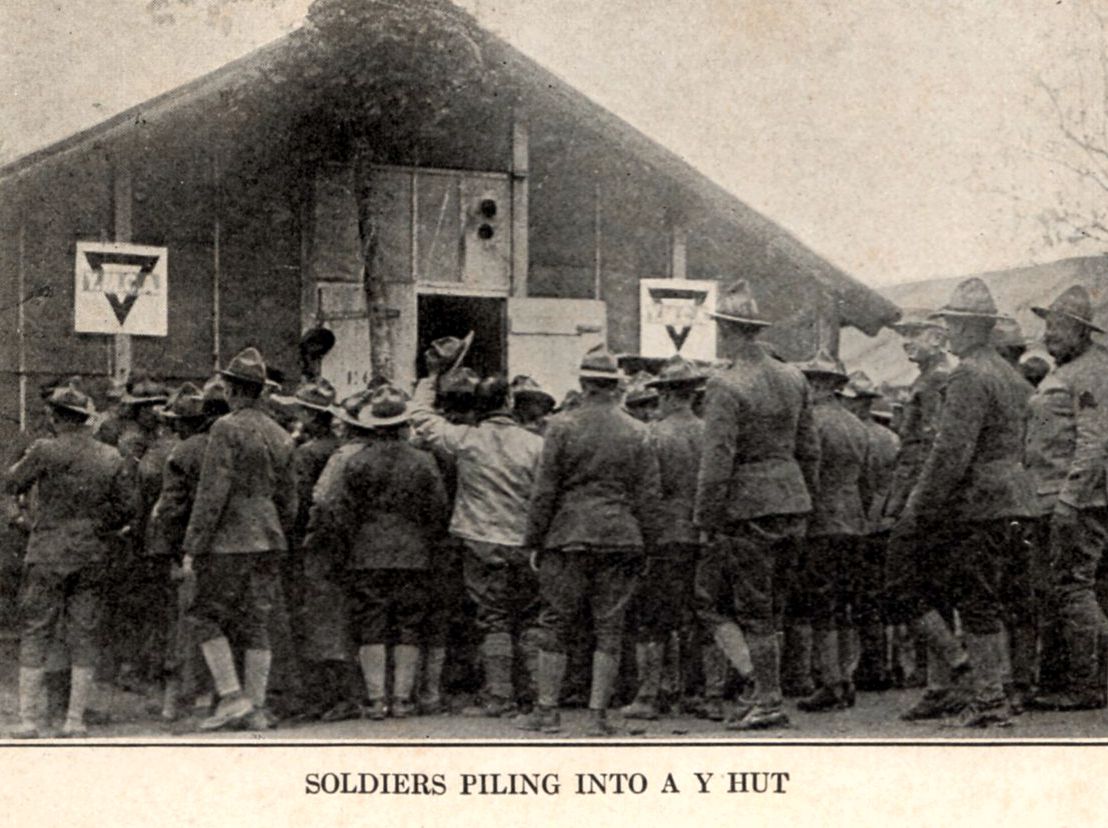
Halcy Stehman
Nurse, Hamilton County, Indiana
"It was a time of excitement, activity, and usefulness in many ways...
It was interesting to see the part the Red Cross played at camp, and to watch different organizations on the parade ground."
Mary Sample, YMCA,
Hancock County, Indiana
“Can a hundred conflicting feelings be compressed into a single line? Can the elation of THEN be reconciled to the disillusionment of AFTER and the half-satisfied, half-cynical acceptance of NOW? It was a tremendous experience! I had not tried anything very big before. For the first time in my life, I bumped against something entirely too big for me to lick. In my efforts to make at least a scratch on the surface, I often found myself doing more than I had ever thought possible, physically, and my Celtic capacity for enthusiasm and idealism knew no bounds. That it was always getting ‘nipped’ by carping criticism, cases of buck-passing, wire-pulling, little straws which prepared me for acceptance of the fact that this war had not ended the war. But there was a gain: we had meant to end it; we had tried our utmost, according to the light we then saw.”
“Irene Castle was a passenger on our ship (September 1918), great was the excitement among the 3000 doughboys. We were nearing the submarine zone, and the lookouts were constantly watching the horizon. Imagine our amusement when we glanced up one day to see their binoculars converging on the shapely ankles of the Irene as she reclined on a deck chair below, as the irresistible apex of an isosceles triangle, and to hell with the submarines!
“Several Japanese diplomats were passengers on our transport. We women excited their curiosity: they couldn't understand why we were being taken over. After patient explanations as to our mission, one shook his head comprehendingly. ‘Ah, American geisha girls….’”
Irene Castle 1917
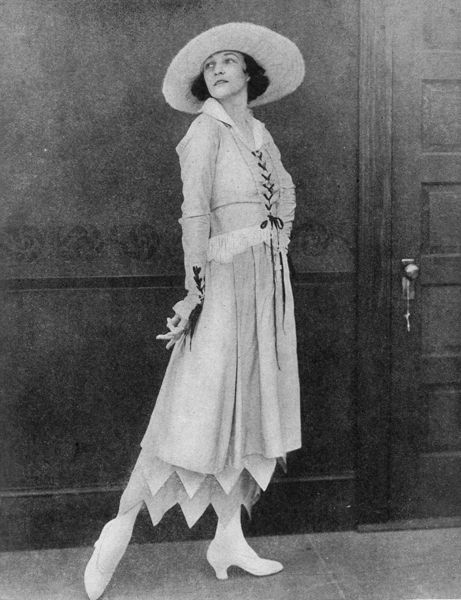
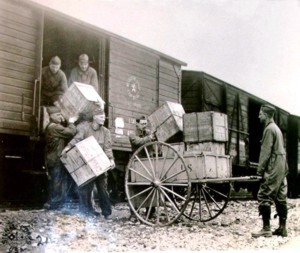
YMCA Secretaries unloading candles and tobacco for Regimental Warehouses supplying 3rd, 4th, 26th, 33rd, 79th, 88th, and 91st Divisions, also 6th, 7th, and 8th Hospital Units, 13th Engineers and several other units. Most of these men are gray-haired and others could not pass the physical examination for military service, France.
Photo courtesy of Indiana War Memorial Archives
Harold Morton Kramer,
United War Work Campaign,
YMCA Secretary,
Clinton County, Indiana
Served two months in the YMCA work at Camp Zachary Taylor, Louisville Kentucky, and then sailed for Bordeaux France, December 7, 1917, on the French liner Espagne. Arrived at Bordeaux, December 17, 1917. Preceded at once to Paris and served on duty there until January 2, 1918. Preceded to Colombey-les-Belles (Meurthe et Moselle), arriving on January 4. Remain there until March 20 in charge and YMCA hut, frequently raided by German airmen. Transferred to Neufchateau hut work. In June, transferred to the lecture department, and toured the fighting front in France and was sent to England and Scotland, where he served with the American sailors. Ordered home late in August 1918, to serve in the United War Work campaign. Sailed from Liverpool, England, August 26, on American transport, Louisville. Arrived New York September 6, and shortly afterward took the platform for the United War Work campaign and served until the signing of the armistice. While serving along the fighting front was frequently under fire.
Adriana Louise Studebaker
American Red Cross
St. Joseph County, Indiana
Served with Smith College Relief Unit and Canteen Service in France:
"An exciting, dramatic nightmare, a horrible waste of men and money. Mob insanity, built by propaganda... most of the girls 'upfront' in mud and cold lost their health." Amusing: "the inevitable proposals - and those who took them seriously, poor damsels!"
Gertrude Upjohn
Army Nurse Corps
Jasper County, Indiana
"I appreciated the opportunity of service. I hugely enjoyed my service during the war. Red Cross did many things to make her stay in service a most pleasant one."
Arthur Forrest Curran
Sergeant Major
Grant County, Indiana
“After the armistice was signed, I began rehearsing a glee club in Langres, France, which was trained by Mr. W. P. McCormick and later known as McCormick's Seventeen Bunkies. Shortly after January 1, 1919, we started on a tour for the YMCA which took us all over France, from Brest to Nice. This small company returned as a unit as a Casual Co. and did entertainment work on the ship coming home."
Hazel Hulva
YMCA Ambulance Driver
Marion County, Indiana
Enlisted in 1916 with Ambulance Drivers, YMCA, NY City but cleared through Indianapolis & Chicago Committee, September 1918. Served at Dijon & Is-sur-Tille, France. “Just one big impression of sacrifice and giving at that time.”
James Garfield Murray
YMCA
Marion County, Indiana
I was one of the 57 American YMCA men who had a narrow escape from the ship “Oronso” on the morning of April 28, one mile off the Irish Coast. The ship sank ten minutes after being torpedoed by a German submarine.
Carina Eaglesfield
YMCA
Marion County, Indiana
Served at Chaumont, Doulaincourt & Stenay, France, and Luxembourg, Belgium. “Interesting, but war is futile and absolutely wasteful.”
Isabel Graf
YMCA Secretary
Miami County, Indiana
“My service was combined Business-Canteen. I was in the office “Y” headquarters, Base Section 1, St. Nazaire, during the day, and helped at various camps in the section evenings, Sunday, etc. Of course, the chief problem after the Armistice was keeping the boys occupied while they were waiting in the camps to get home – that and helping them get home.
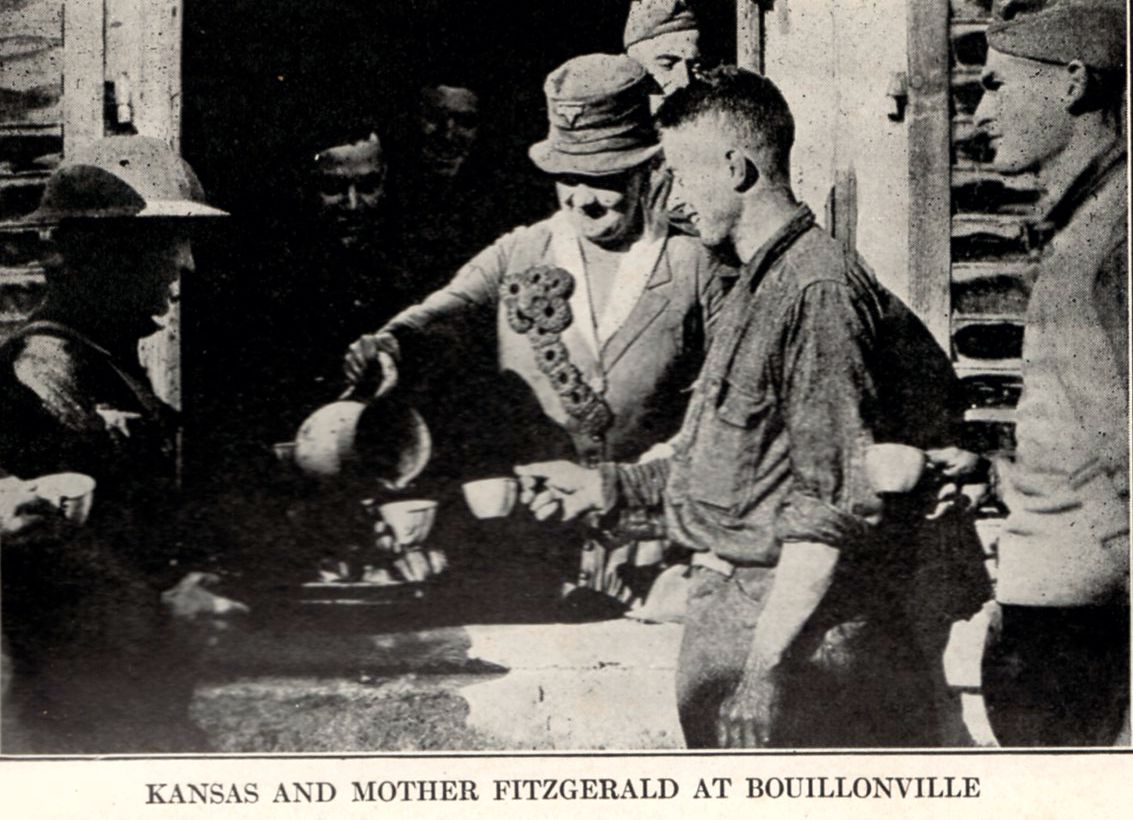
The canteen at Bouillonville
North-East France
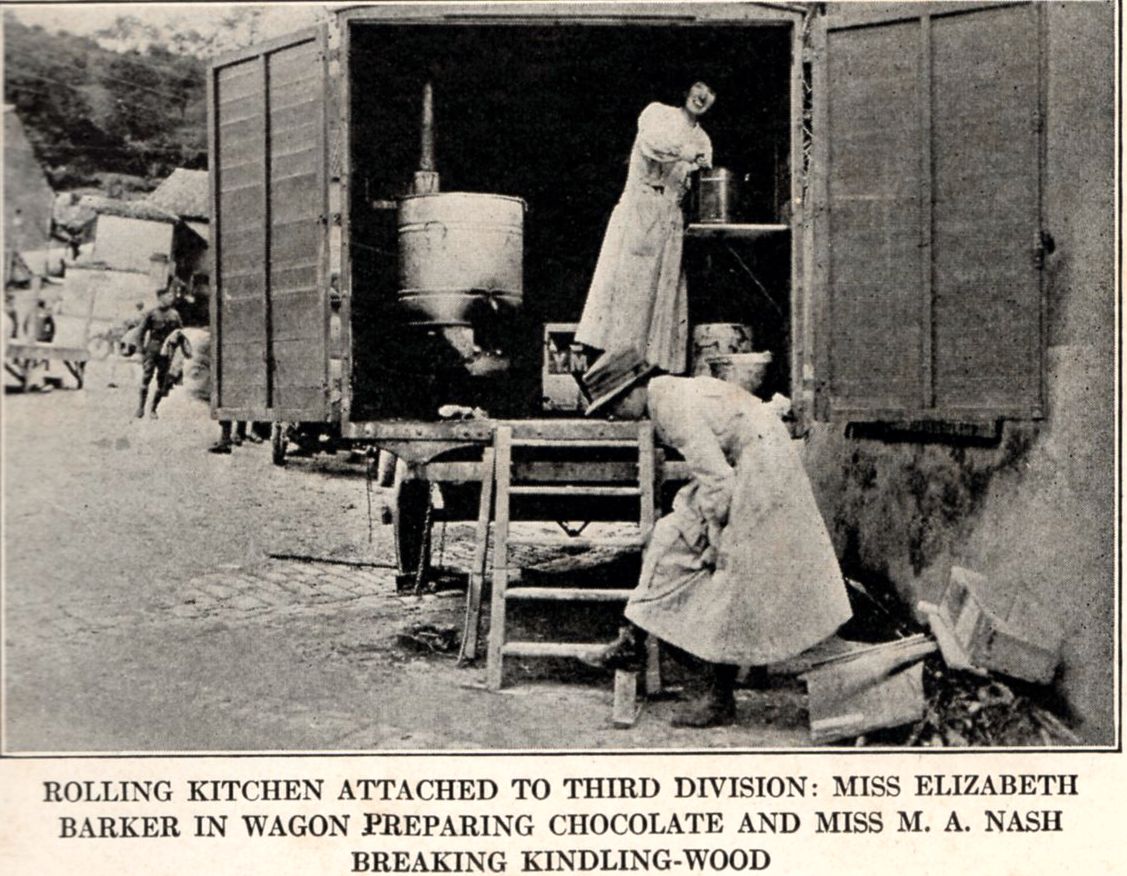
Rolling Kitchen for 3rd Division
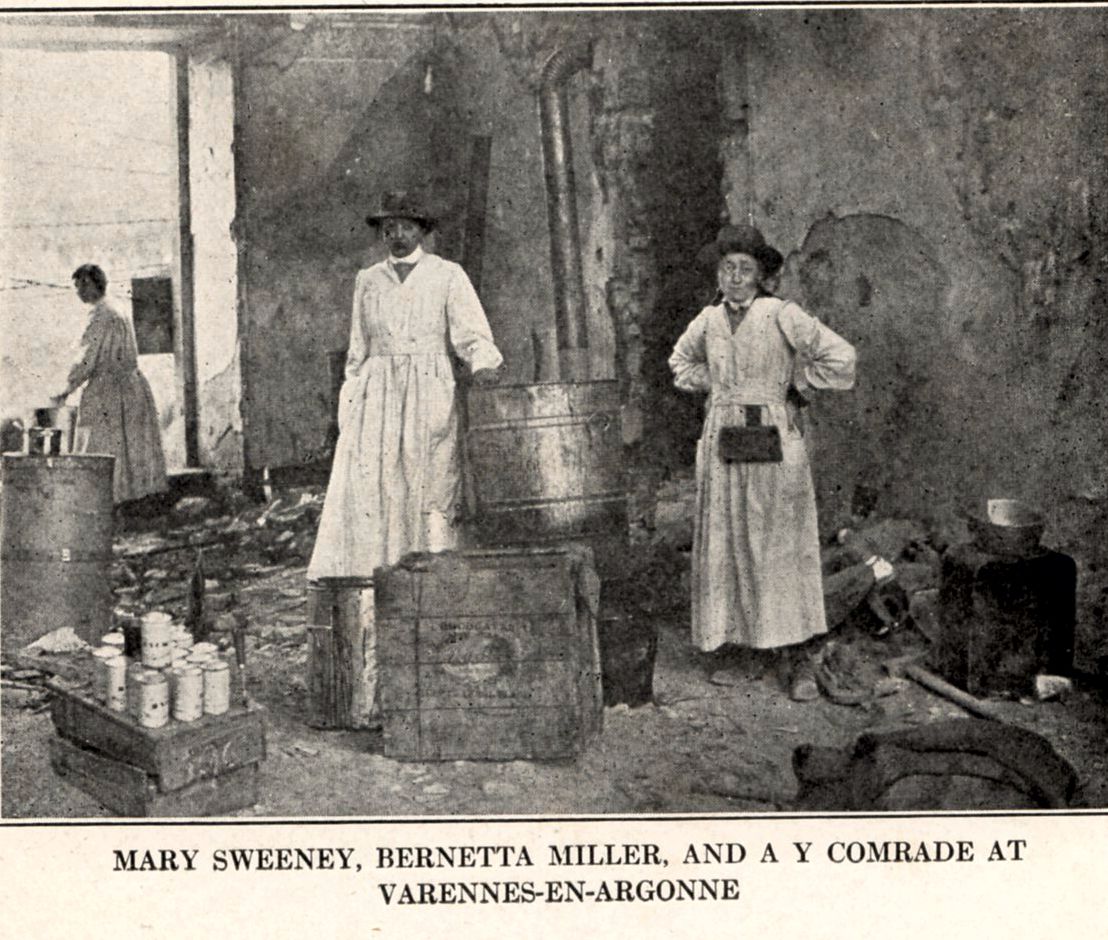
The canteen at Varennes-en-Argonne
North-East France
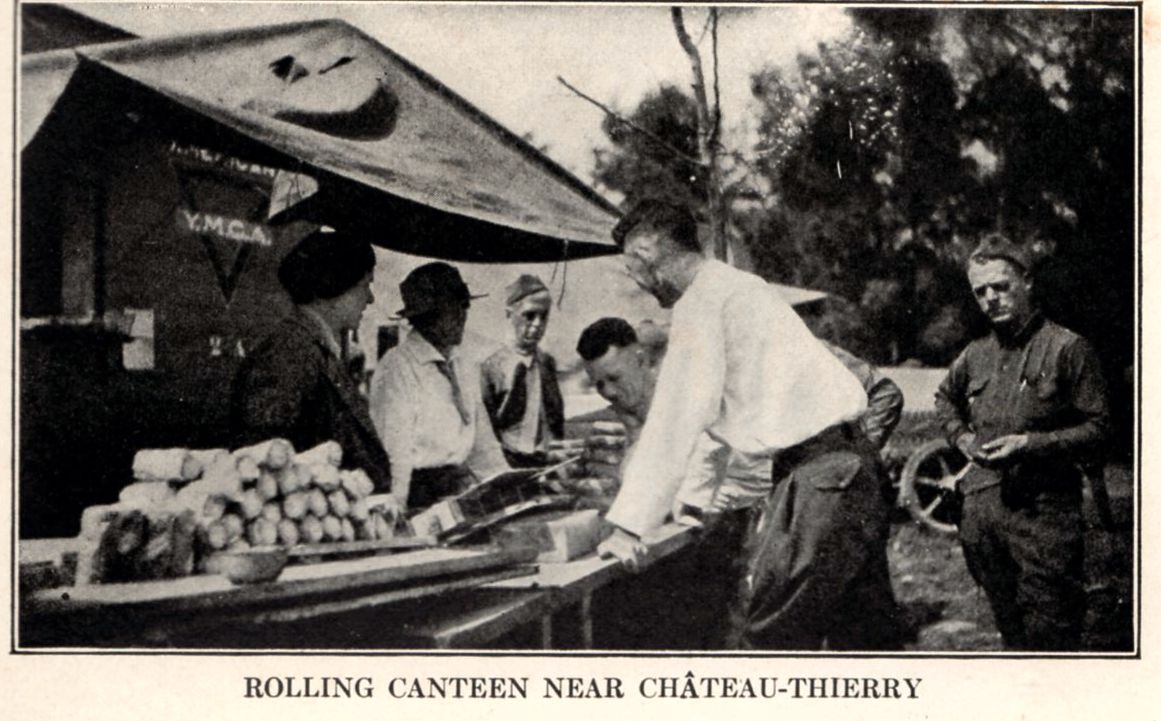
Rolling Canteen Chateau-Thierry
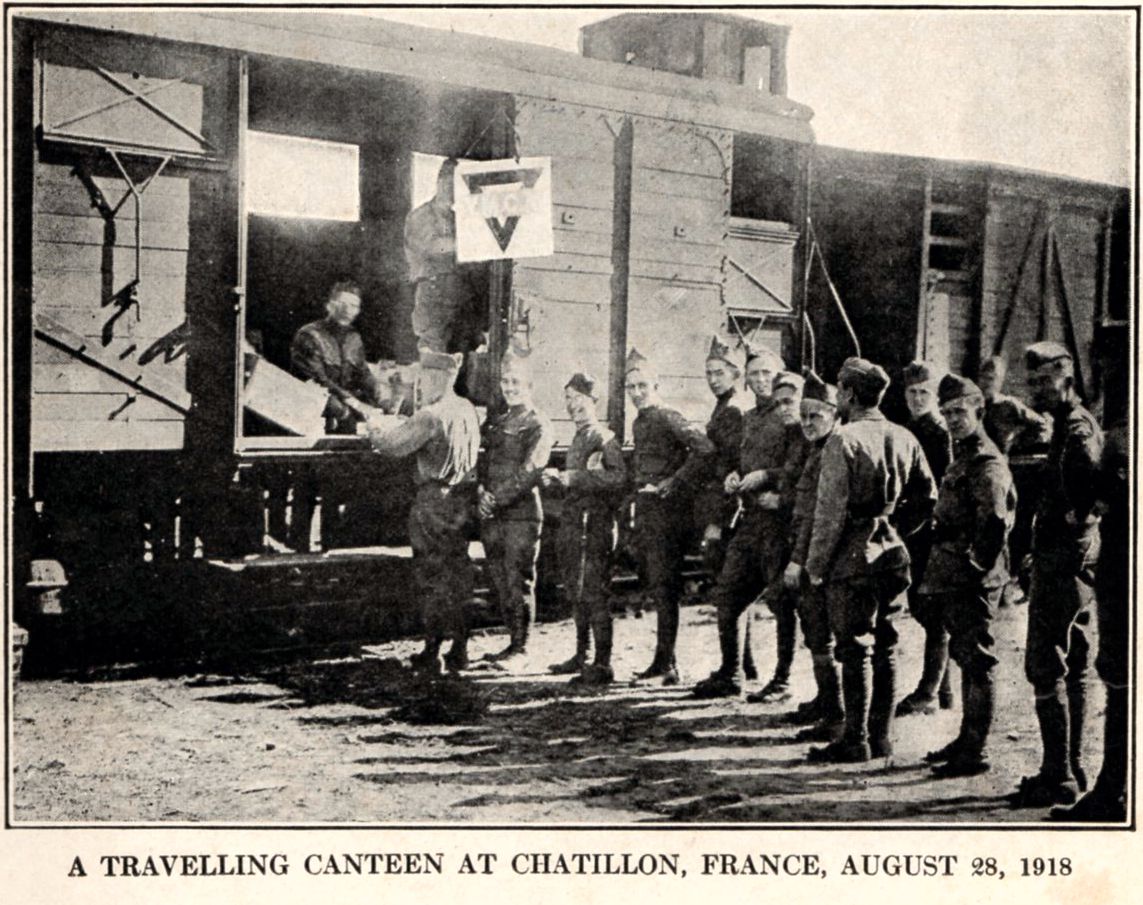
The Canteen at Chatillon, France
August 28, 1918
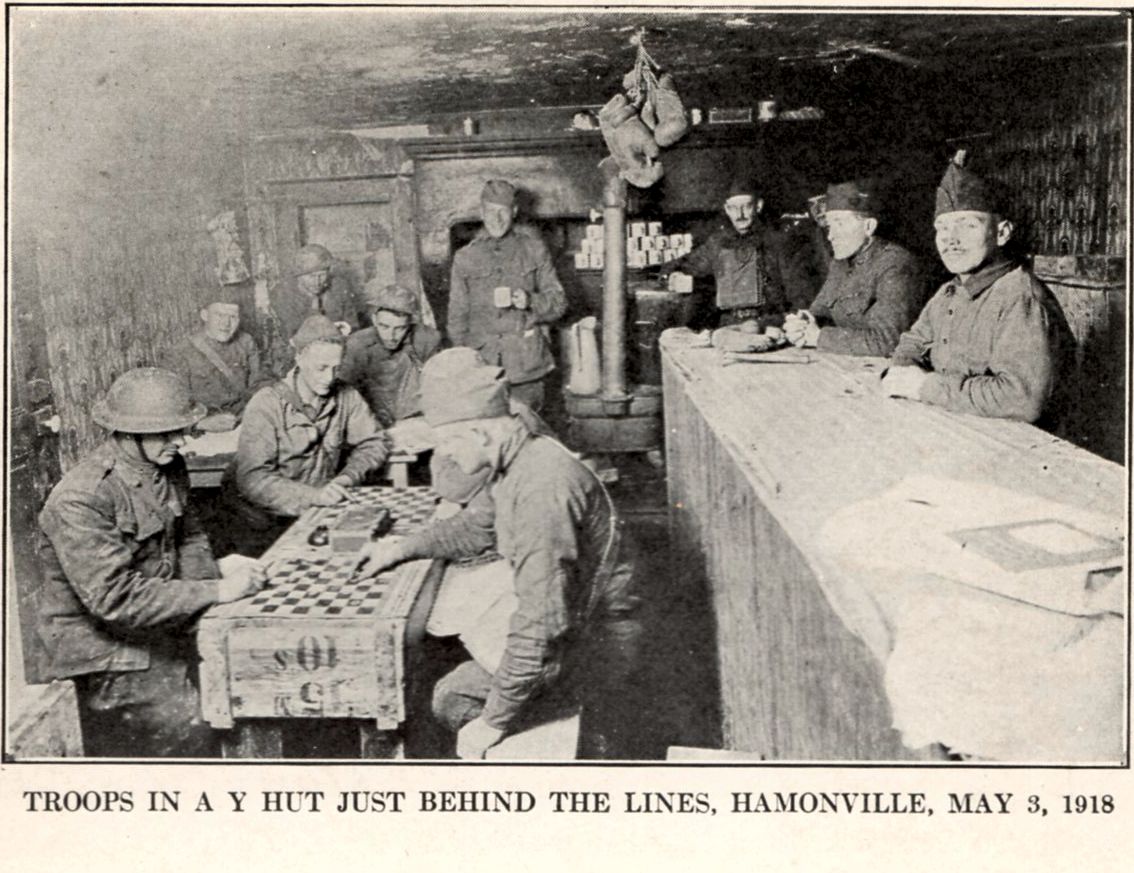
Y Hut behind the Lines
Hamonville, France May 3, 1918
Other Services:
Rest & Relaxation on the Riviera
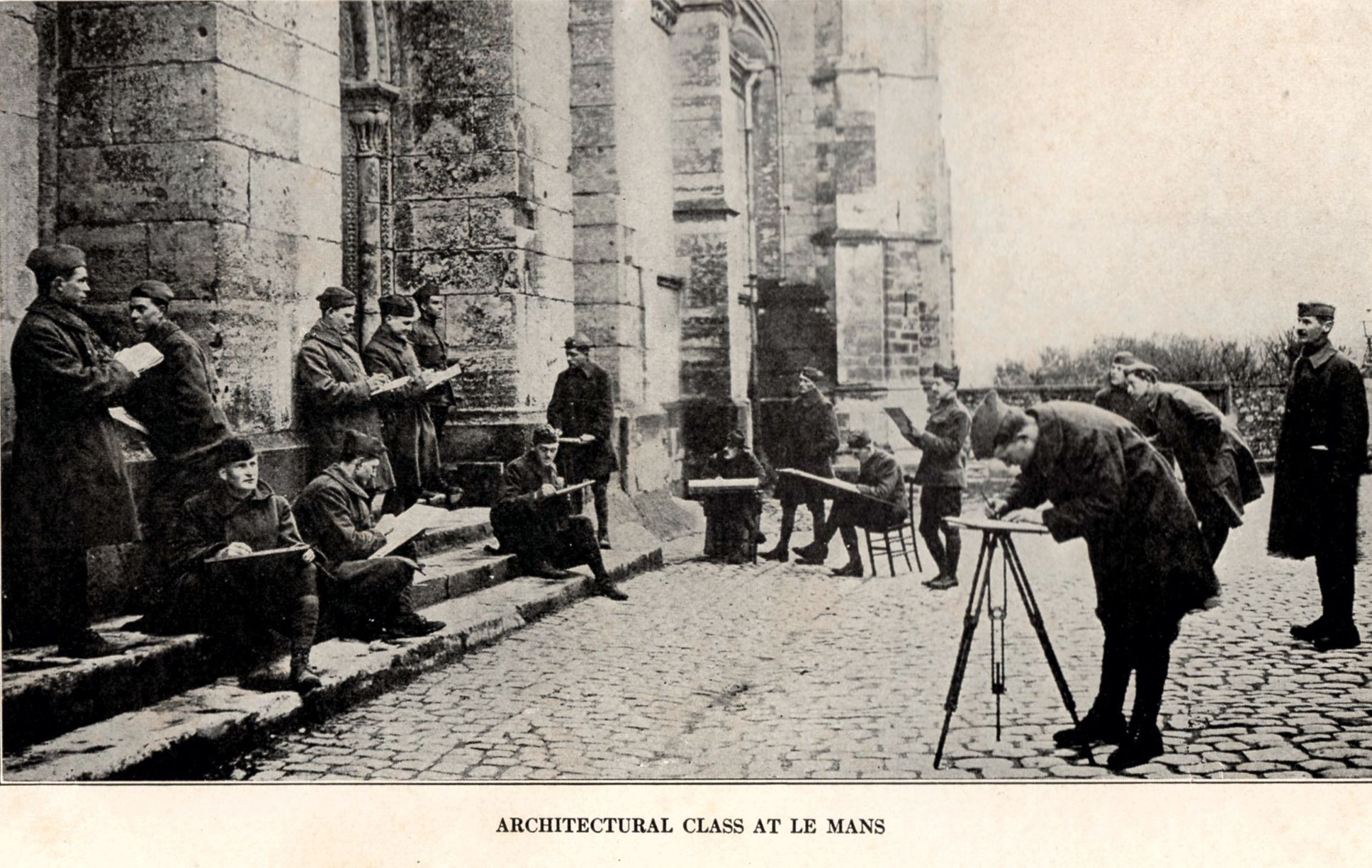
Architectural Class at Le Mans, France
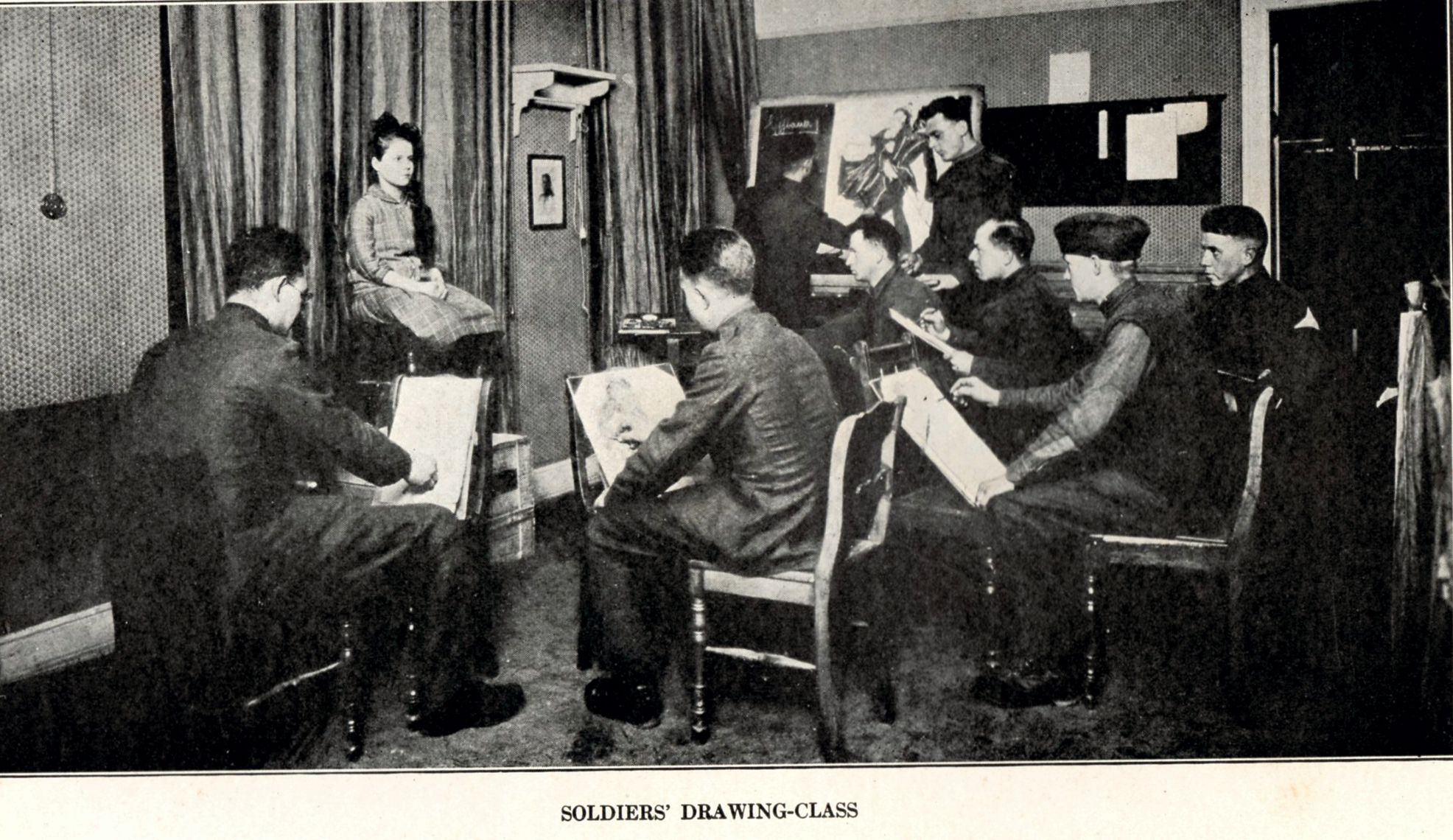
Soldiers Drawing Class Unidentified site.
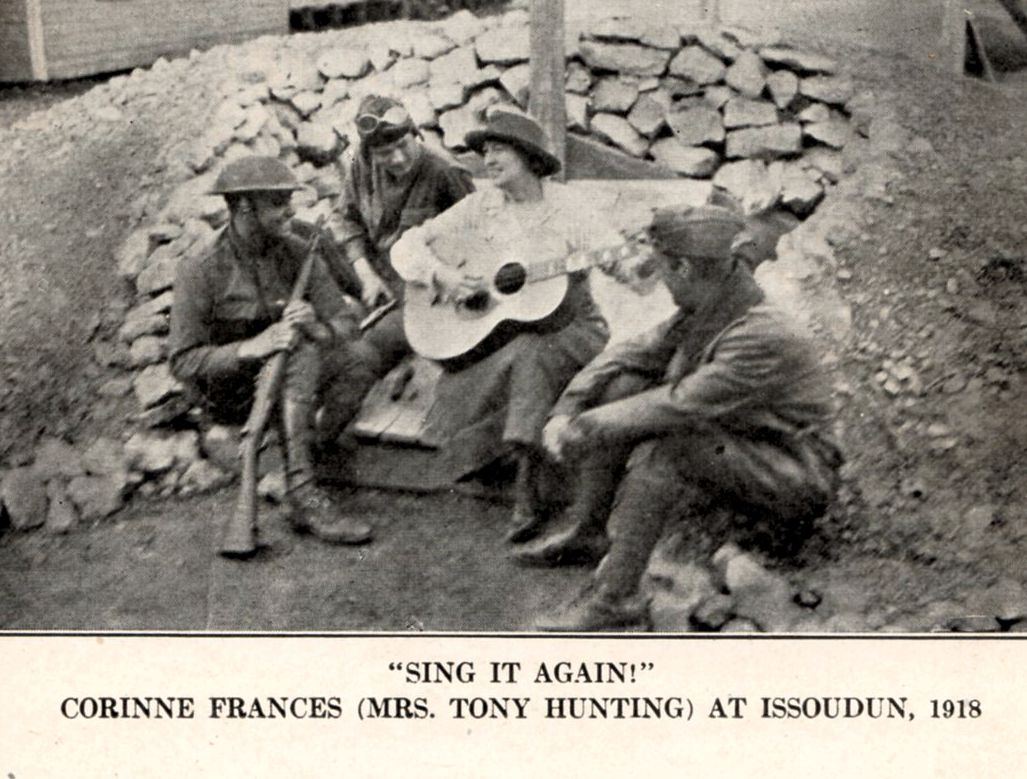
Entertainment at Issoudun, France 1918
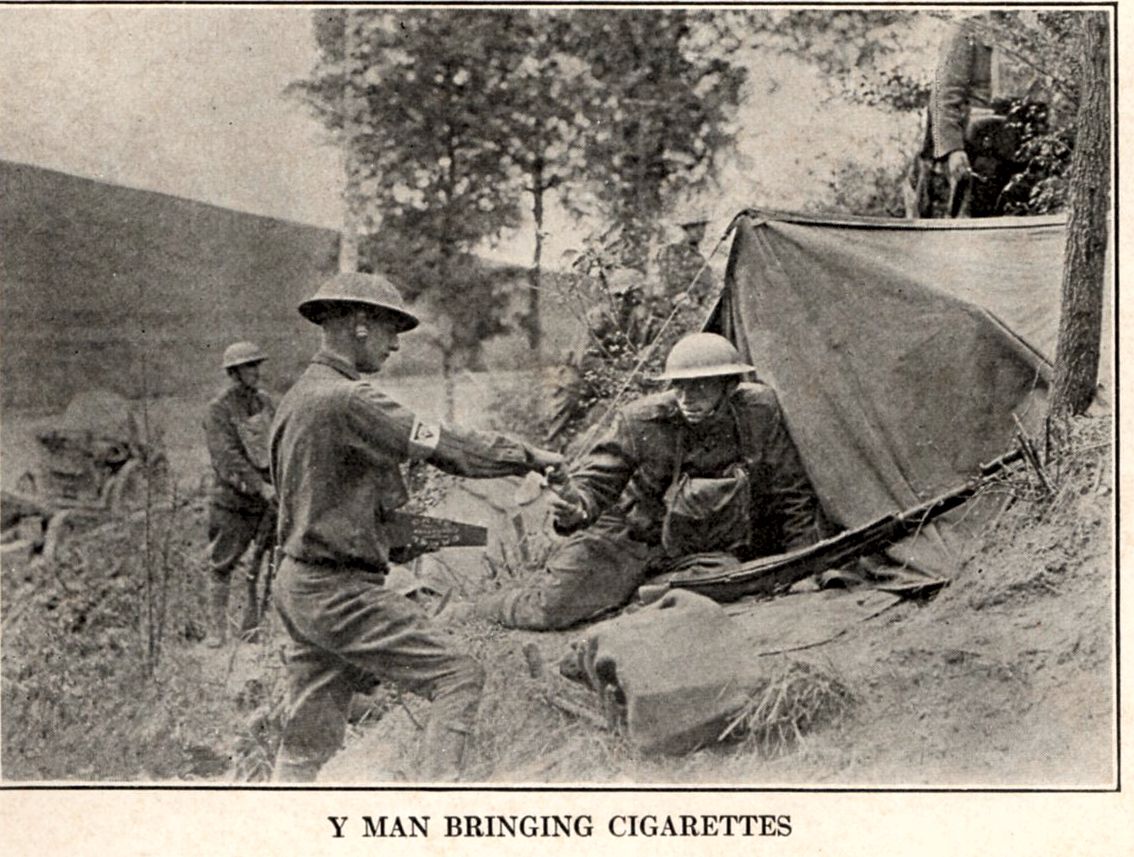
Bringing cigarettes to the troops
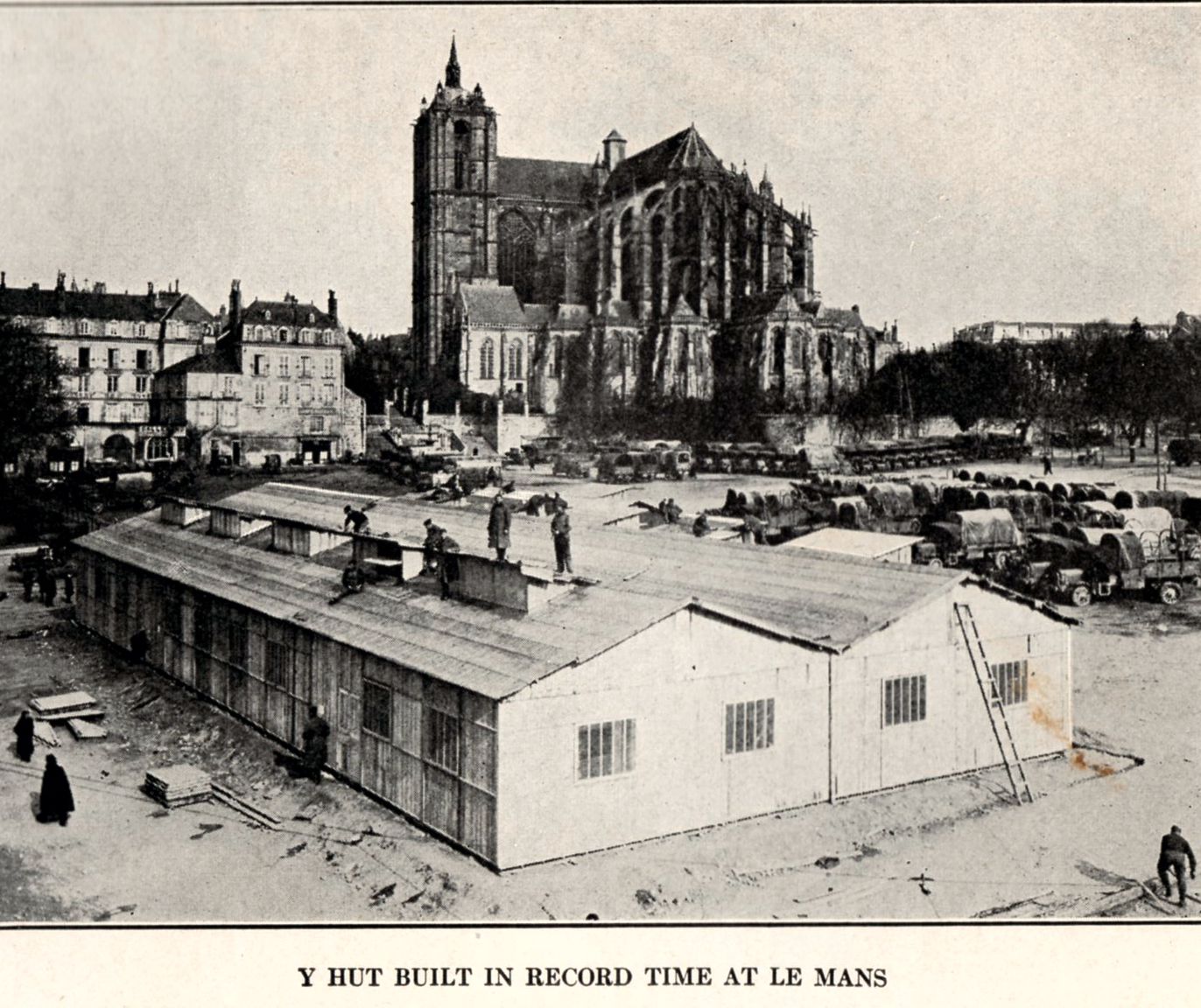
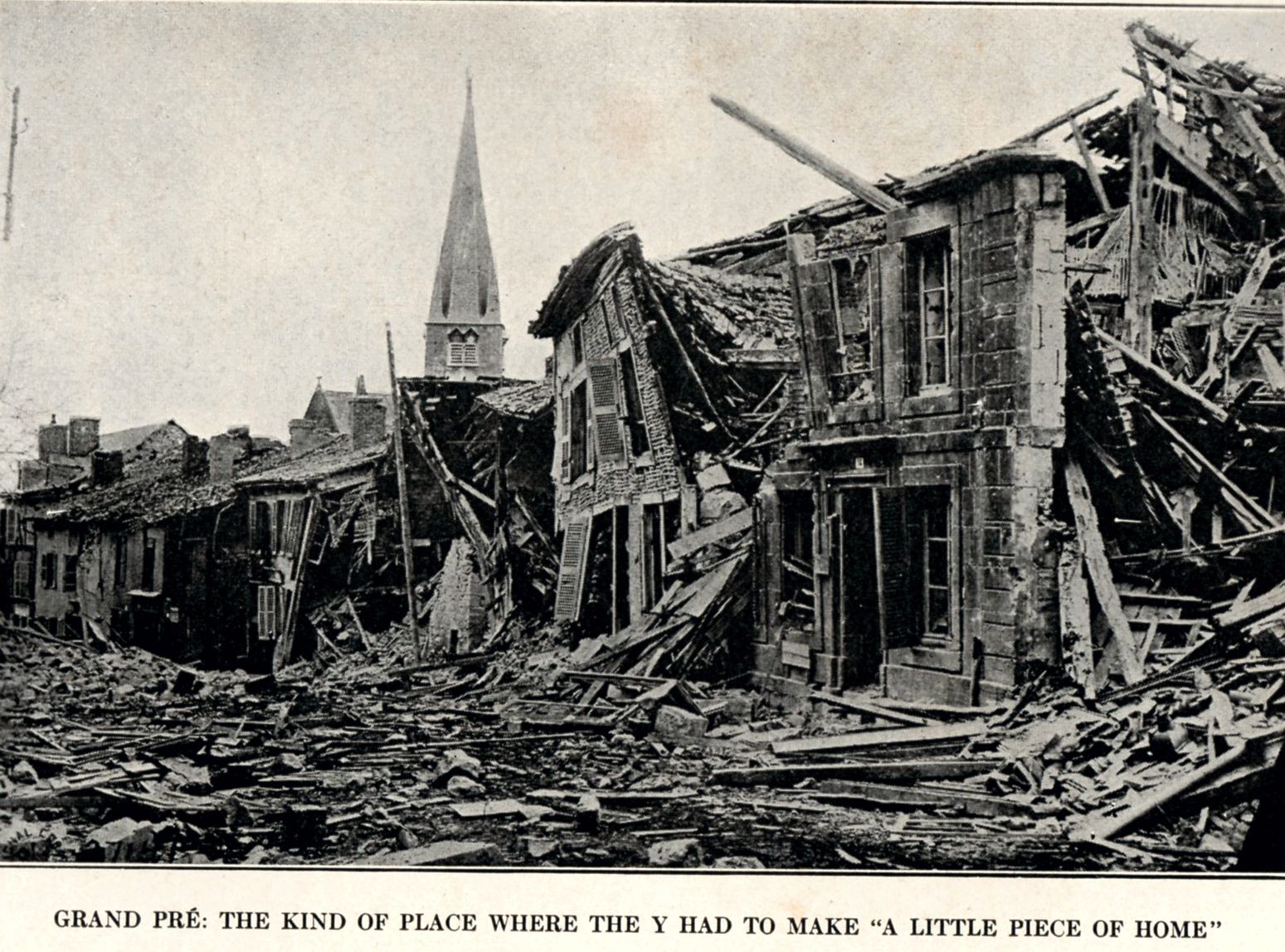
Challenge: to create a safe space for the Doughboys
in the ruins of Grand Pre, France
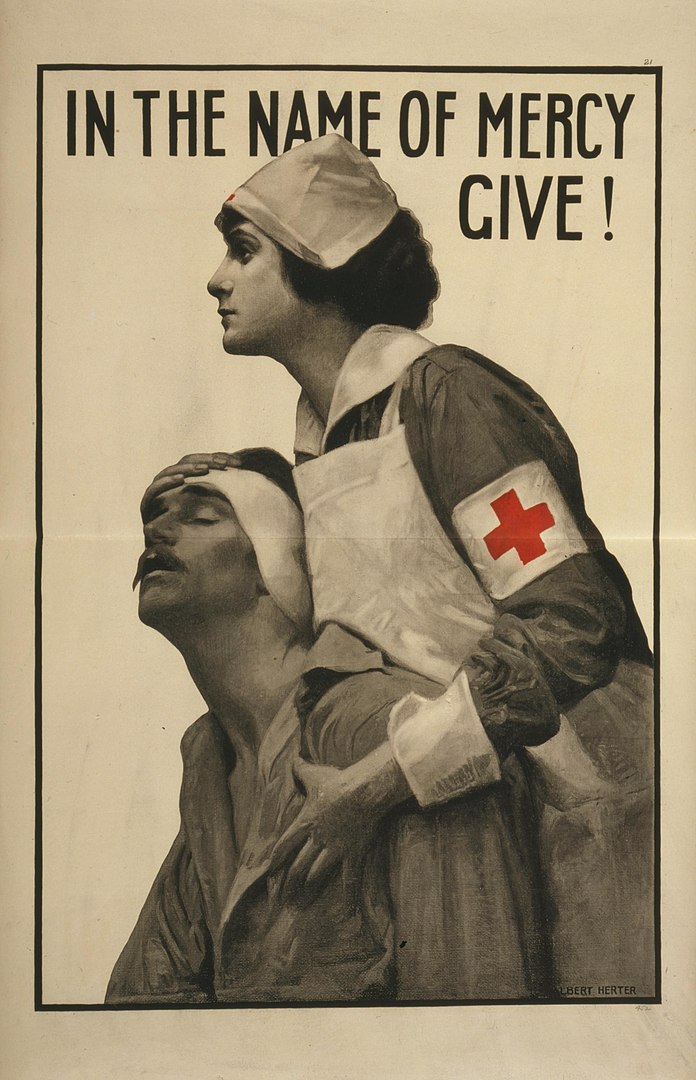
Red Cross Poster
Willard and Dorothy Straight Collection, Library of Congress, Call Number: POS - WWI - US, no. 357, Reproduction Number: LC-USZC4-8369
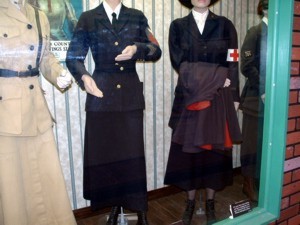
Nursing Corps and Red Cross Uniforms from the Indiana War Memorials Exhibit
Tending to gas victims
As the United States neared its declaration of war with Germany, the US Surgeon general asked the American Red Cross to organize base hospitals for service to the military. The Red Cross eventually established 54 hospitals overseas, mostly in France, with four set up at home.
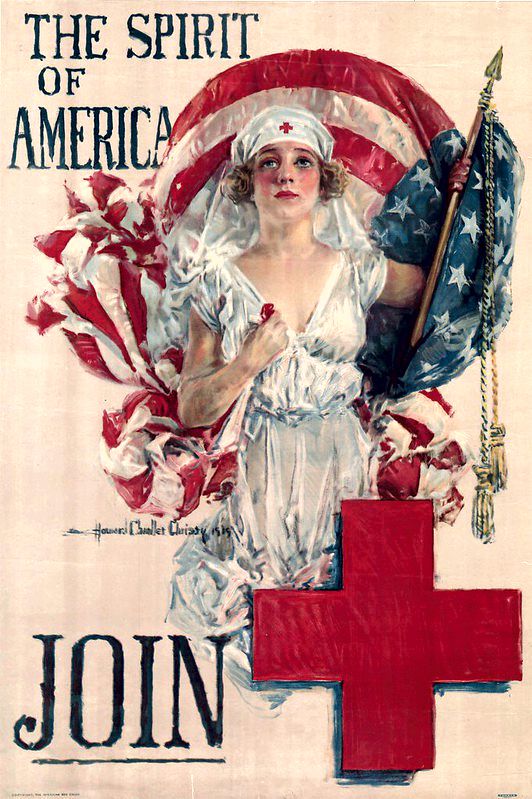
The Red Cross in World War 1:
The Red Cross services were intended to be independent, neutral, and impartial but were soon subordinate to their respective governments and became an important part of the war effort. The Geneva Convention of 1906 made provisions for national Red Cross societies around the world to aid in medical services in the event of war.
Red Cross trained nurses were among the best trained in the Medical Corps. They provided x-ray units, ambulance services, auxiliary hospitals, and surgical care that proved invaluable to wartime lifesaving efforts.
The Red Cross played a major part in humanitarian services during wartime. They aided prisoners of war and provided information to desperate families on the home front on the location and condition of POWs. They aided in communications between prisoners, restoring family links, and helped distribute parcels, mail and aid as much a permitted.
They also aided civilian populations with assistance to refugees and medical services and supplies. They provided a distribution system between donations of food, clothing, money, linens, furniture, tools, and especially infant needs to see they reached the refugees and displaced persons in need.
They aided military and acted as an auxiliary of the US Public Health Service with civilian populations providing medical assistance for tuberculosis, typhus, Spanish influenza.
President Woodrow Wilson was an honorary chairman of the US Red Cross. 8,000,000 Red Cross volunteers were mobilized in the war effort.
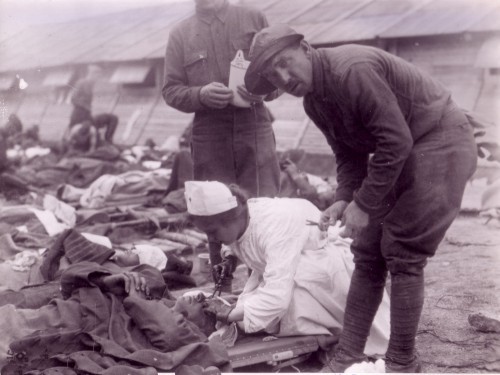
WW1 Red Cross Recruiting Poster
US Army Signal Corps photo
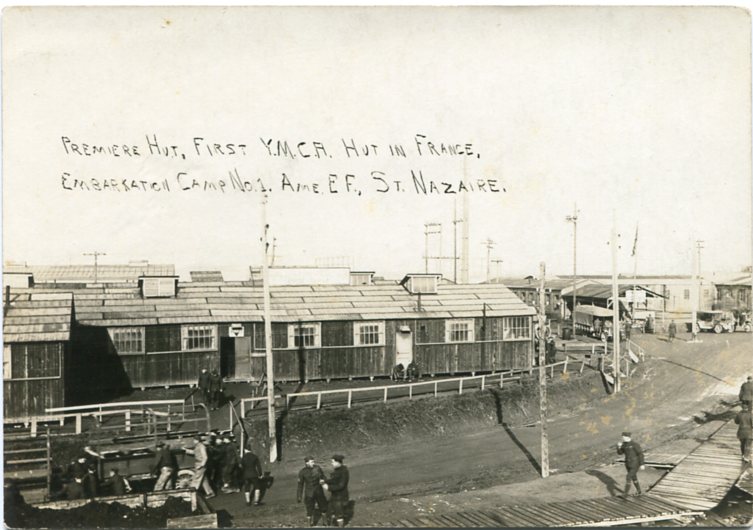
View taken from a ship in the port of Saint-Nazaire, France, of the Premiere Hut, the first YMCA hut in France at U.S. Army Embarkation Camp No. 1 during World War I. Photograph believed to be printed from a real-photo postcard (Undated).
From Thomas C. Alston Papers, WWI 66, WWI Papers, Military Collection, State Archives of North Carolina, Raleigh, N.C.
